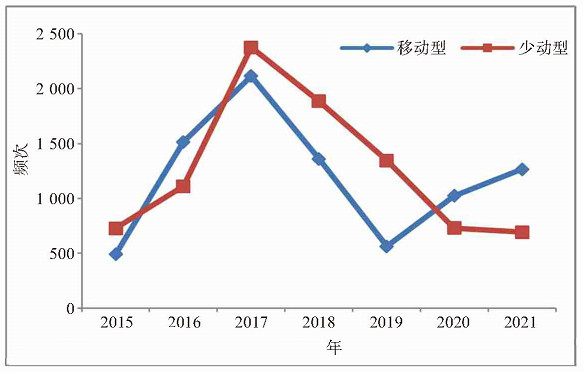CHARACTERISTICS OF LOCAL THERMAL CONVECTION IN SUMMER AFTERNOON UNDER WEAK SYNOPTIC-SCALE FORCING IN ZHEJIANG
-
摘要: 利用常规高空观测资料、浙江多普勒雷达产品、ERA5逐小时再分析资料(0.25 °×0.25 °),统计分析了2015—2021年浙江夏季(6—8月)弱天气尺度强迫背景下午后局地热对流(根据移动速度分为移动型和少动型两类)的时空分布特征、生命周期特征、环境参数特征等。(1) 两类热对流触发频次相当,年际变化均较大,但年、月、日变化趋势基本一致,午后出现少动型局地热对流的可能性更大,而傍晚出现移动型局地热对流的可能性更大。(2) 局地热对流的触发与地形密切相关,对流高频区位于浙东沿海、浙西北、浙西南山区,浙中北平原和盆地均为低频区,热对流触发频次均随高度增加而减少,多触发于山脉及其附近的中低海拔处,中高海拔地区更容易触发少动型局地热对流。(3) 两类对流均在弱垂直风切变环境下即可触发,移动型单体更容易得到发展。Abstract: Based on high-altitude observational data, Zhejiang Doppler radar products, and ERA5 hourly reanalysis data (0.25 °×0.25 °), the present study analyzed the spatial and temporal distribution, life cycle, and environmental parameters of local thermal convection (classified into localized moving convection and localized anchoring convection according to moving speed) in the afternoon under the background of weak synoptic-scale forcing in summer (from June to August) in Zhejiang from 2015 to 2021. The results show that: (1) The triggering frequency of the two types of thermal convection is the same, and the interannual variation is large, but the annual, monthly and daily variation trends are basically the same. Localized anchoring convection easily occurs in the afternoon while localized moving convection easily occurs in the evening. (2) The triggering of local thermal convection is closely related to the terrain. The high-frequency area is located in the coastal areas of eastern, northwestern, and southwestern mountainous areas in Zhejiang while the low-frequency area is located in the plain and basin in central and northern Zhejiang. The triggering frequency of thermal convection decreases with the increase in height, which is mostly triggered at the middle and low altitudes in the mountains and nearby. It is easier to trigger localized anchoring convection in the mid- and high-altitude areas. (3) Both types of convection can be triggered in the environment of weak vertical wind shear, and localized moving convection is easier to develop.
-
Key words:
- weak synoptic-scale forcing /
- localized thermal convection /
- terrain /
- altitude /
- convection parameters
-
表 1 雷达站及探测范围
雷达站 睢州雷达 杭州雷达 湖州雷达 宁波雷达 台州雷达 温州雷达 丽水雷达 金华雷达 舟山雷达 探测范围 衢州、杭州南部 嘉兴、绍兴、杭州中北部 湖州 宁波 台州 温州 丽水 金华 舟山 -
[1] CARBONE R E, TUTTLE J D. Rainfall occurrence in the U.S. warm season: The diurnal cycle[J]. J Climate, 2008, 21(16): 4 132-4 146. [2] KIM H W, LEE D K. An observational study of mesoscale convective systems with heavy rainfall over the Korean Peninsula[J]. Wea Forecasting, 2006, 21(2): 125-148. [3] COHEN A, CAVALLO S, CONIGLIO M, et al. A review of planetary boundary layer parameterization schemes and their sensitivity in simulating southeastern US cold season severe weather environments[J]. Wea Forecasting, 2015, 30(3): 591-612. [4] 张小玲, 谌芸, 张涛, 等. 对流天气预报中的环境场条件分析[J]. 气象学报, 2012, 70(4): 642-654. [5] 郑永光, 张小玲, 周庆亮, 等. 强对流天气短时临近预报业务技术进展与挑战[J]. 气象, 2010, 36(7): 33-42. [6] 王秀明, 周小刚, 俞小鼎, 等. 雷暴大风环境特征及其对风暴结构影响的对比研究[J]. 气象学报, 2013, 71(5): 839-852. [7] 俞小鼎, 周小刚, 王秀明, 等. 雷暴与强对流临近天气预报技术进展[J]. 气象学报, 2012, 70(3): 311-337. [8] 王镇铭, 杜惠良, 杨诗芳, 等. 浙江省天气预报手册[M]. 北京: 气象出版社, 2013: 9-10. [9] 朱乾根, 林锦瑞, 寿绍文, 等. 天气学原理[M]. 北京: 气象出版社, 2007: 431-432. [10] 李昀英, 宇如聪, 傅云飞, 等. 一次热对流降水成因的分析和模拟[J]. 气象学报, 2008, 66(2): 190-202. [11] 杨茜茜, 张述文, 任星露, 等. 不同边界层参数化方案对一次局地热对流降水的高分辨率模拟的影响[J]. 兰州大学学报, 2019, 55(5): 681-692. [12] 束宇, 姜有山, 张志刚, 等. 对流温度在局地热对流降水预报中的应用[J]. 气象, 2015, 41(1): 52-58. [13] LIN P F, CHANG P L, BEN J J, et al. Warm season afternoon thunderstorm characteristics under weak synopic-scale forcing over Taiwan island[J]. Wea Forecasting, 2011, 26(1): 44-60. [14] DIEM J E. Synopic-scale controls of summer precipition in the southeastern United States[J]. J Climate, 2006, 19(4): 613-621. [15] 付伟基, 陆汉城, 王亮, 等. WRF模式对弱强迫系统雷暴预报个例研究[J]. 气象科学, 2009, 29(3): 323-329. [16] 俞小鼎, 姚秀萍, 熊延南, 等. 多普勒天气雷达原理与业务应用[M]. 北京: 气象出版社, 2006: 187-193. [17] 管理, 戴建华, 赵渊明, 等. 上海地区暖季午后对流的雷达气候学特征分析[J]. 气象, 2020, 46(12): 1 543-1 554. [18] 韩国泳, 李兰兰, 荆涛, 等. 鲁中地区一次漏报的强对流天气过程中地形触发作用分析[J]. 干旱气象, 2016, 34(3): 540-546. [19] 孙继松, 陶祖钰. 强对流天气分析与预报中的若干基本问题[J]. 气象, 2012, 38(2): 164-173. [20] 孙继松, 石增云, 王令. 地形对夏季冰雹时间时空分布的影响研究[J]. 气候与环境研究, 2006, 11(1): 76-84. [21] 孙继松. 北京地区夏季边界层急流的基本特征及形成机理研究[J]. 大气科学, 2005, 29(3): 445-452. [22] 吕劲文, 姚日升, 涂小萍, 等. 浙江省6-9月午后短时强降水空间分布特征分析[J]. 暴雨灾害, 2019, 38(4): 320-328. [23] 马淑萍, 王秀明, 俞小鼎. 极端雷暴大风的环境参量特征[J]. 应用气象学报, 2019, 30(3): 292-301. [24] 陈雷, 戴建华, 汪雅. 近10a长三角地区雷暴天气统计分析[J]. 暴雨灾害, 2015, 34(1): 80-87. [25] 仇娟娟, 何立富. 苏沪浙地区短时强降水与冰雹天气分布及物理量特征对比分析[J]. 气象, 2013, 39(5): 577-584. [26] 樊李苗, 俞小鼎. 中国短时强对流天气的若干环境参数特征分析[J]. 高原气象, 2013, 32(1): 156-165. [27] 樊李苗, 俞小鼎. 杭州地区夏季午后雷暴大风环境条件分析[J]. 气象, 2020, 46(12): 1 621-1 632. [28] JOHNS R H, DOSWELL Ⅲ C A. Sever local storms forecasting[J]. Wea Forecasting, 1992, 7(4): 588-612. [29] 严红梅, 梁亮, 黄艳, 等. 金华地区18次冰雹天气的大气环境与雷达回波特征分析[J]. 暴雨灾害, 2019, 38(1): 48-58. -






 下载:
下载:









 粤公网安备 4401069904700003号
粤公网安备 4401069904700003号